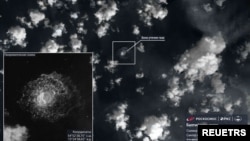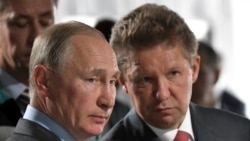On October 3, posts about an American economist accusing the United States of blowing up the Nord Stream 1 and 2 gas pipelines in Europe blew up on Weibo, China's equivalent of Twitter.
The two Russian-constructed pipelines under the Baltic Sea, where leaks became evident September 26, were designed to deliver natural gas from Russia to Germany. However, because of sanctions over Russia’s war against Ukraine, they were not in operation.
Based on seismological readings suggesting explosions, European officials have said that the ruptures “are the result of a deliberate act” and state actors were probably involved. But who did it? That is yet to be determined pending ongoing European investigations.
Labeled “American economist said bluntly that the Nord Stream [pipeline] was blown up by the United States,” a video clip showing Columbia University professor and economist Jeffrey Sachs speaking with Bloomberg News garnered nearly 84 million views on Weibo.
“I would bet [the explosion] was a U.S. action, perhaps U.S. and Poland,” he told Bloomberg News before host Tom Keene interjected and asked for evidence for the claim.
Sachs claimed there is evidence U.S. helicopters were in the area of the pipeline ruptures and cited statements made by President Joe Biden’s administration:
“Well, first of all, there is direct radar evidence that U.S. military helicopters that are normally based in Gdansk were circling over this area.
“We also had the threat from the United States earlier this year that ‘one way or another we are going to end Nord Stream.’
“We also had a remarkable statement by Secretary of State [Antony] Blinken last Friday in a press conference… He says, ‘This is also a tremendous opportunity.’ It’s a strange way to talk if you’re worried about piracy on international infrastructure of vital significance.”
Sachs said people he talked to “all over the world” and some U.S. reporters agreed “privately” that the U.S. was responsible for the leaks.
Sachs’ claims are misleading and echo narratives pushed by the Kremlin and amplified by Chinese diplomats and Chinese state media.
Polygraph.info has reported on the Kremlin’s false claim that President Biden had threatened to sabotage the Nord Stream pipelines.
Russia, together with a slew of Twitter accounts with a track record of spreading anti-West propaganda and conservative media personalities in the U.S., also seized on the Blinken comment mentioned by Sachs and treated it as a strong indication that the U.S. was behind the sabotage.
Sachs took Blinken’s remark about “opportunity” out of context.
On September 30, Blinken held a press conference with his Canadian counterpart Melanie Joly and was asked about U.S. actions in helping alleviate the worsening energy crisis in Europe in the aftermath of the pipeline sabotage.
Before the war and sanctions, Russia provided about 40 percent of Europe’s natural gas and about half of Germany’s. The Nord Stream 2 pipeline, while completed, never came online. At the beginning of September, Russia stopped pumping natural gas to Germany through the older Nord Stream 1 pipeline.
Blinken noted that Europe had made significant efforts in decreasing energy demand and is working to transition to renewable sources.
“[U]ltimately this is also a tremendous opportunity,” Blinken told reporters. “It’s a tremendous opportunity to once and for all remove the dependence on Russian energy and thus to take away from Vladimir Putin the weaponization of energy as a means of advancing his imperial designs.”
It is no secret that Washington has long opposed the Nord Stream pipelines out of concern over European dependence on Russian natural gas.
“It is true that the Biden administration, just like its predecessors, opposed the Nord Stream pipelines because they would increase European dependence on Russia,” Max Boot, a senior fellow at the Council on Foreign Relations, wrote in The Washington Post.
“But it is bizarre to think that the United States would undertake an act of sabotage that could hurt our closest allies in Europe and add to inflationary pressure at home.”
Boot added that Biden has been successful in uniting European allies in opposing Russian aggression in Ukraine and “would never risk the blowback from an attack on European energy infrastructure.”
Some military observers, while in no way suggesting any U.S. involvement in the sabotage, said Blinken handed the Kremlin a propaganda win.
“The U.S. Secretary of State calling the damage to the Nordstream [sic] pipelines a ‘tremendous opportunity’, after Russia has insinuated the U.S. is responsible for the incident, is a massive unforced error,” Patrick Fox, U.S. Air Force veteran and military affairs analyst, wrote on Twitter.
Sachs’ reference to “U.S. helicopters” over the area of gas leaks is also misleading, according to German news outlet Deutsche Welle (DW).
The source of this allegation appears to be a September 27 Telegram post by Russian think tank Vatfor. The post alleged that on September 2, Vatfor “noticed interesting maneuvers performed by an American helicopter with the call sign FFAB123,” later identified as a Sikorsky MH-60S, the U.S. Navy’s multi-mission helicopter.
“By superimposing the FFAB123 route on the scheme of yesterday's accident, we get a rather interesting result – the helicopter either flew along the Nord Stream 2 route, or even between the points at which the accident occurred,” Vatfor wrote.
Problem is, that’s not accurate.
DW checked the flight route of the FFAB123 helicopter on September 2 using the FlightAware aviation tracking web site. DW also identified the geo-coordinates for the exact locations of the gas leaks using Danish Maritime Authority’s website.
DW’s findings contradict Vatfor:
“On September 2, the flight tracker shows a flight route near Bornholm, which actually corresponds to the image posted on social media. Flight FFAB123 flew in several loops over the Baltic Sea east of the island of Bornholm. If one superimposes the geo-coordinates of the gas leaks and flight route on a map, however, a different picture emerges than that claimed in the social media posts.
“FFAB123 did not fly along the pipeline and did not even come close to the locations of the gas leaks. In particular, the northern gas leaks are far from FFAB123's flight path. According to our measurements, the flight path of FFAB123 was nine or 30 kilometers (5 or 18 miles) respectively away from the localized gas leaks.”
DW concluded the Russian claim “that an American helicopter was responsible for the gas leaks is untenable and misleading.”
In the U.S., Pentagon officials told reporters during an October 4 press briefing that “the U.S. was in no way involved” in the attacks on the Nord Stream pipelines. When Polygraph.info followed up to ask specifically about the helicopter, a spokesperson repeated the denial.
As Europe investigates the source of explosions, Western governments have cautioned against speculation about who is responsible.
“This is something that is extremely important to get all the facts on the table, and therefore this is something we’ll look closely into in the coming hours and days,” NATO Secretary-General Jens Stoltenberg said on September 27.
While Putin baselessly accused the West of attacking the pipelines during a TV address, no Western government has determined that Russia was responsible for the attack.
However, many Western observers have named Russia as the chief suspect.
Russia’s Gazprom owns the pipelines. Regarding the question of why Russia would attack its own pipelines that aren’t even in use, and seemingly lose the leverage of energy over Europe, political scientist and historian Mark Galeotti wrote in The Spectator magazine:
“The answer is likely to be as a warning. If you want to signal that, if pushed to escalation, you might regard foreign pipelines and other undersea assets as fair game – and the underwater cables that are the arteries of the global internet are the obvious concern here – then a safer option is to hit your own.
“[European Commission President] Ursula von der Leyen has taken time out from explicitly threatening the Italians to implicitly threatening the Russians, warning that any deliberate disruption of European energy infrastructure would be met by the 'strongest possible response.' But it is harder to seriously respond when the infrastructure isn't yours, isn’t in use, and isn’t likely to be used in the future.”
Tom Rogan, national security writer for The Washington Examiner newspaper, wrote:
“It seems absurd to believe Russia would blow up its own pipelines and associated gas export market. But that is to consider this incident through a Western security prism. Russian intelligence service culture revels in actions with unpredictable risk-benefit assessments and darkly theatrical conduct. Moreover, the pipelines were hardly even operating before the attack. Nord Stream II was completely, if belatedly, suspended by Germany following Russia's February invasion of Ukraine. Putin recently shut down Nord Stream I so as to blackmail the West into weakening its sanctions regime.”
“[W]hile European gas prices had gone down recently, a shock like the Nord Stream leaks could potentially rattle the energy markets once again, less for what it actually means and more for the reminder of how fragile the energy situation is,” Vox magazine wrote, citing EU-Russian relations expert Stefan Meister.
Meister also emphasized the fact that the pipelines not currently in use are “pretty useless” to Russia.
“That means [the way] to make use of it is to blow it up to impact the gas market,” Meister told Vox. “It’s not on the current situation of the gas supply, but it’s more on psychology.”
On September 28, Kremlin spokesman Dmitry Peskov called speculation from the West that Russia blew up its own pipeline “quite predictable and also predictably stupid.”
“This is a big problem for us because, firstly, both lines of Nord Stream 2 are filled with gas – the entire system is ready to pump gas and the gas is very expensive ... Now the gas is flying off into the air."
“Are we interested in that? No, we are not, we have lost a route for gas supplies to Europe,” Peskov said.







